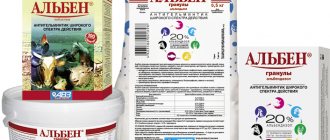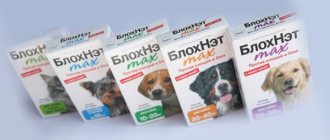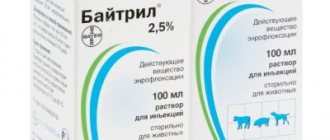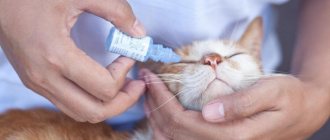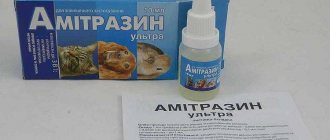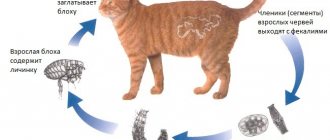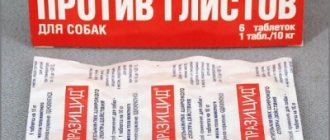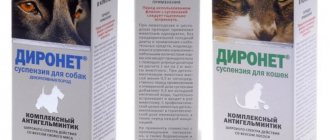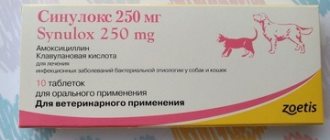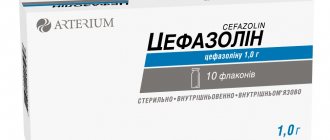Pharmacodynamics and pharmacokinetics
The use of this medication can effectively get rid of many types of parasites. Therefore, it is used in the treatment of lice , scabies , onchocerciasis , nematodes in humans, as well as animals. The drug Ivermectin is intended for both external and internal use and injection.
Ivermectin is part of a group of products created on the basis of avermectins . As is known, they are a product of the vital activity of bacteria such as Streptomyces avermitilis. Avermectin is an insecticide that is used as an insect bait. It also serves as the basis for the creation of some anthelmintic drugs.
Inside the body, Ivermectin undergoes rapid absorption, reaching its maximum concentration in the blood within 4 hours. The substance is evenly distributed in tissues and is eliminated from the body through the intestines in 1-2 days.
The drug is capable of blocking the transmission of neuromuscular impulses, which causes paralysis of parasites and subsequent death. However, the wide range of effects of the drug does not indicate its toxicity. In fact, the toxicity of Ivermectin is not at all high, provided that precise dosing is observed.
Release form and composition
Ivermek is rightfully considered a leader among antiparasitic drugs. It is produced on the basis of two components and their combination - Ivermectin and vitamin E. An increased level of effectiveness of the product is ensured by the original water-dispersed (micellar) form.
According to the dosage form, the product is presented as a solution for injection by intramuscular route. The drug is a solution of a transparent, opalescent, colorless or yellow structure. Sterile.
1 ml of injection solution contains the following active ingredients:
- 10 mg Ivermectin;
- 40 mg tocopherol acetate (vitamin E).
The additional components used are substances such as dimethylacetamide, polyethylene glycol-660-hydroxystearate, benzyl alcohol, as well as water for injection.
The solution for injection is packaged in glass bottles or polymer containers of 1, 10, 20, 50, 100, 200, 250, 400 and 500 ml. To seal the bottles, special rubber stoppers are used, which are reinforced with aluminum caps. Labeling and packaging of medicines has its own characteristics depending on the capacity:
- When packaged in 1 ml bottles, labeling is used that indicates the manufacturer's data, name of the product and volume. Information about the batch number and expiration date is also included. Bottles are packed in 50 units. in cardboard packs together with a sheet of instructions for use.
- If the medicine is packaged in containers with a unit capacity of 10-500 ml, then the labeling includes the name of the manufacturer, its address, and trademark. The cardboard packs contain information about the name of the product, purpose, method of use, and the volume of medicine in each bottle. Data on the active component, the number of bottles in the package, series, production date, expiration dates and storage conditions are recorded. For identification purposes, the inscriptions “For Animals” and “Sterile” are applied. There is also an indication of state registration numbers, and compliance with the display of specifications is confirmed. The medicine comes with instructions.
Indications for use
The drug is widely used in the treatment of infections caused by roundworms, for example, for:
- onchocerciasis;
- strongyloidiasis;
- ascariasis;
- trichocephalosis;
- filariasis;
- enterobiasis.
In addition, it can be used in the treatment of scabies and lice , if people do not have weakened immune defenses.
Limitations and Cautions
The drug should not be used together with medicinal formulations that contain macrocyclic lactones, since mutually reinforcing toxicity is possible. If animals are planned to be used for slaughter, this can be done no earlier than 28 days from the end of treatment. For birds, this limitation period is 9 days. If slaughtered earlier than the specified dates, the meat may be used for feeding fur-bearing animals.
Important! The use of milk from dairy animals has its limitations - it can be used for food no earlier than 28 days after the end of therapy. If the milk was obtained earlier, then it is used to feed livestock and other animals, but only after the boiling procedure.
Contraindications
The main contraindications for use are:
- children under 5 years of age and body weight up to 15 kg;
- lactation, pregnancy;
- renal and liver failure ;
- intolerance to the drug and its components;
- weakened immune system;
- asthma , meningitis.
Dosage
The use of Ivermek involves a one-time intramuscular injection:
- for piglets and adults for colitis, the medicine is injected into the inner part of the thigh (thigh muscle), into the neck;
- for other animals - in the area of the croup and neck. For dogs - at the withers, the area between the shoulder blades.
Recommended dosage:
- For cows, small cattle (sheep, goats), horses, 1 ml of veterinary preparation is required for every 50 kg of body weight.
- For pigs and piglets - one ml per 33 kg.
- For dogs, cats, rabbits - 0.1 ml per 5 kg of weight.
Important! If the dosage of the veterinary drug at a time exceeds 10 ml, we recommend placing injections at different points on the body.
Horses are given injections in the neck and croup.
Against nematodes and cestodes, Ivermek is prescribed to animals before being kept in stalls, in early spring before being put out to pasture. It is best to administer the product against botfly larvae as a preventive measure immediately after the end of the insects' summer. Against pathogens of arachno-entomosis, ectoparasites - according to indications, throughout the entire period of parasite activity.
If necessary, in severe cases, with severe helminthic infestations, for deprivation, treatment with Ivermek is carried out twice with an interval of 7–10 days.
Ivermectin, instructions for use (Method and dosage)
Detailed instructions for use of Ivermectin for humans recommend its use orally. In this case, a single dosage averages 12 mg, but the exact calculation is made taking into account body weight. The doctor also determines how many appointments are required, since there should be a gap of 1-2 weeks between them.
Children over 5 years old and weighing more than 15 kg are prescribed a dose of 150 mcg per kg of weight.
This drug can be used in the treatment of certain parasitic diseases, for example: scabies , helminthiases , myiases and others. It is allowed to take 2 doses - orally or by injection, with an interval of 1-2 weeks. In addition, the drug can be used topically and applied to affected areas.
In addition, drugs based on Ivermectin are widely used in veterinary medicine to treat domestic animals for various parasitic diseases. At the same time, the instructions for dogs indicate that it can also be prescribed internally or used externally. A drug such as Ivermectin 1% or Ivermec is prescribed in a single dosage at the rate of 300 mcg per kg of animal weight.
Overdose and side effects
If the dosages specified in the instructions are exceeded, livestock may develop a depressed state, tremors, and increased salivation. Animals may refuse to eat and develop loose stools. However, there are no specific detoxification agents. If problems arise, it is necessary to follow general measures in order to remove the active components of the drug from the body, and it is also necessary to use somatic therapy.
The specific effects of the veterinary drug on the body of livestock during its initial use or in case of withdrawal have not been identified. It is important not to allow deviations from the existing treatment and prevention regimen, as this will likely cause a decrease in the effectiveness of the application. If it was admitted that the treatment of livestock was missed according to plan, then, while maintaining the same dose, it is advisable to treat the animal as quickly as possible.
No side effects or complications were observed during the use of Ivermek. However, in case of excessive sensitivity of the body to the action of Ivermectin, in some cases, excessive excitability and increased salivation may occur. There may be cases of frequent bowel movements and urination, signs of ataxia.
Typically, these symptoms go away on their own and do not require additional treatment. If there is a high sensitivity to the drug and there are signs of allergy, then it is possible to prescribe antihistamines, as well as treatments for the symptomatic group.
Reviews of Ivermectin
Despite the fact that this drug is quite difficult to purchase in the Russian Federation, reviews about it are often found. Patients who have already undergone treatment report that Ivermectin for humans is a very effective remedy that helps to quickly get rid of parasites. However, the development of side effects occurs only in rare cases.
However, the main problem is the inability to purchase this drug in regular pharmacies. Some companies offer to bring it to order from Germany, India or Poland. Therefore, users simply flood the forums with questions “where to buy?” and actively share links to companies and individuals who can deliver the drug from abroad, which, in general, is very risky.
Interestingly, some users recommend purchasing this drug from a veterinary pharmacy. They claim to have purchased Ivermectin for dogs and used it successfully on themselves. Of course, this should not be done, since if this drug is prescribed to a person, the doctor assumes that it will be a medicine for people.
According to veterinary experts, the drug Ivermec is usually used in the treatment of parasitic diseases. Therefore, when Ivermectin is prescribed for cats, it is usually any product created on its basis. It is also available in the form of a solution and is equally highly effective. However, you must first consult with a specialist. Only with this approach can you be sure of a favorable treatment outcome.
Pharmacology and biological effects
Ivermec has an active antiparasitic effect due to the presence of Ivermectin. This substance enhances the production of gamma-aminobutyric acid, which is an inhibitory neurotransmitter. Therefore, the transmission of impulses is disrupted, which creates conditions for paralysis and destruction of parasites.
A pronounced antiparasitic effect is exerted on the course of the larval and mature phases of nematode development in the gastrointestinal tract and in the lung area. The product also affects the development of gadfly larvae of the subcutaneous, nasopharyngeal and gastric varieties. As a result of the action of Ivermek, lice, bloodsuckers and sarcoptic mites are rapidly dying.
Parenteral administration of the drug is accompanied by rapid absorption of Ivermectin directly from the injection site. Then distribution occurs throughout the organs and tissues of animals, which leads to the preservation of the parasitocidal effect for from 10 days to 2 weeks. The drug is excreted from the animal’s body along with urine and bile. If the animal is in the lactation phase, then excretion occurs along with milk.
The requirements of GOST 12.1.007-76 determine the level of influence of drugs on animals. According to them, Ivermec should be considered a moderately hazardous substance, which is confirmed by the 3rd hazard class. But the active ingredient Ivermectin itself will be a component characterized by an extremely high class 1 hazard. If the dosage is observed during the administration of the drug, then there is no embryotoxic, teratogenic and mutagenic effect. The destruction of active components is observed quite quickly in the environment.
Storage conditions and periods
Store Ivermek in the manufacturer's sealed packaging, separately from food and feed, in a dry place, protected from light, at a temperature from 0°C to 25°C.
The shelf life of the medicinal product, subject to storage conditions in a closed package, is 2 years from the date of production, after the first opening of the bottle - no more than 42 days.
After the expiration date, Ivermek should not be used.
Should be stored out of the reach of children.
Unused medicinal product is disposed of in accordance with legal requirements.
How does Ivermec work?
The composition of the produced forms of Ivermec includes ivermectin, which acts against sarcoptic and demodex mites and their larvae, which cause skin diseases.
Ivermectin interrupts the transmission of nerve impulses to the muscles, which paralyzes and kills ectoparasites and helminths.
Ivermec is effective against otodectosis in cats
Ivermectin, included in external forms, is practically unable to penetrate the systemic bloodstream. It accumulates in the outer layer of the skin - the epidermis, hair follicles and sebum-producing glands; destroys ticks while maintaining the effect for 5–7 days. Dosage forms of Ivermek for external use do not affect helminths.
Lidocaine, included in the spray and gel, has an analgesic effect, reduces skin itching and reduces the likelihood of self-harm when scratching. Dexpanthenol accelerates the recovery of skin damage. The chlorhexidine contained in the spray acts against secondary microbial flora.
Personal prevention measures
When working with Ivermek, you should follow the general rules of personal hygiene and safety precautions provided for when working with medications. Drinking, smoking and eating are prohibited during work.
After finishing work, wash your hands with warm water and soap.
In case of accidental contact of the drug with the skin or mucous membranes of the eyes, they must be rinsed with plenty of water.
People with hypersensitivity to the components of the drug should avoid direct contact with Ivermek.
If allergic reactions occur or if the drug accidentally enters the human body, you should immediately contact a medical facility (bring with you the instructions for use of the drug or the label).
Empty vials and bottles of medicinal products must not be used for household purposes; they must be disposed of with household waste.
Ivermectin price and brands
Trademarks: Ivermectin, Stromectol, Mectizan.
The price of Ivermectin tablets (made in India) when ordering online is 5,700 rubles. – equivalent to 100 US dollars.
The average cost of medicines in Russian pharmacies is:
- Ivermek 500 ml – 1770 rub.
- Ivermectin - 10 bottles 100 ml - 1440 rub.
- Ivermek-gel – 420 rub.
- Ivermek spray – 310 rub.
- Cream-gel “Solantra” - 1,423 rubles.
- Otodectin 10 ml – 116 rub.
Side effects
Clinically documented side effects in humans are not explained by the toxicity of Ivermectin, but by the intake of toxic substances released by parasites upon death.
After use you may experience:
- deterioration of general condition, weakness, dizziness;
- muscle pain;
- tachycardia;
- nausea, diarrhea;
- increased drowsiness, loss of consciousness;
- disruption of the digestive system;
- swollen lymph nodes;
- allergic reactions;
- burning, itching, dryness, irritation of facial skin;
- trembling of limbs, ataxia, disorientation.
Skin reactions (burning, itching, dryness, irritation) are caused by the presence of alcohol in the cream-gel, which leads to drying. Auxiliary components may provoke allergic reactions.
Tremor, ataxia, and disorientation can occur as a result of poisoning of the body, since clinical signs of intoxication are associated with effects on the brain.
In animals, with the exception of individual intolerance, no side effects are observed.
Feedback from cat owners
I became acquainted with this drug about 5 years ago, when I picked up a cat on the street with scabies almost at the last stage. The drug is excellent, has a wide spectrum of action, kills many types of skin parasites and worms. And most importantly, cheap and cheerful. Already after the first injection, the results of treatment are noticeable. With advanced scabies, in about 10–20 days, the cat is almost completely overgrown... But you need to be very careful with this drug, as it is very toxic. If you make a mistake in the dosage, you can kill the animal.
dianchik949
https://otzovik.com/review_1369601.html
Our koshandel from Ivermek gave a gastric reaction half an hour after the first dose was administered. The poor guy was sick and twisted inside out. I marked the floor of the apartment with the contents of my stomach until everything came out.
He refused to eat for two days, we already thought that we would lose the kote. It passed slowly, thank God. But I had to use a different drug.
Lex-Ta
https://irecommend.ru/content/ivermek-dlya-koshek-ne-samoe-luchshee-lekarstvo
Ivermek-gel, which has already been written about here, is Rulez. There was nothing I could do to cure the cat’s ears - the situation was similar to yours. All kinds of drops don’t help, but this gel is a miracle! If you apply it, the cat doesn’t get nervous, the gel covers the inner surface well and stays on. I anointed it again after another two weeks. It was as if nothing had happened!
yarportal.ru/topic78565s15.html
special instructions
It is necessary to approach the use of Ivermectin with caution when:
- heart failure;
- liver dysfunction;
- kidney diseases;
- disorders of the digestive system.
The drug puts a strain on the body, therefore it is undesirable for use by people engaged in physical labor, patients with central nervous system dysfunction, and patients with epilepsy.
Hot weather is a negative factor.
It is not recommended to use Ivermectin continuously for more than 3 months, since the body and living parasites become accustomed.
The drug has a long-lasting effect, is eliminated from the body for a long time, and has an extremely low degree of destruction at high temperatures. The other side of the coin is restrictions on the consumption of processed animal products.
Ivermectin derivatives have been found in the milk of dairy animals for a long time. Slaughter and milking for food purposes are prohibited for a month. Entering the human body in pure or metabolized form can cause poisoning, allergies, and dysbacteriosis.
Interaction with other drugs
Ivermectin increases the level of warfarin in the blood, so it cannot be used simultaneously with Warfarin and Phenilin.
It is not recommended to take it together with barbiturates, psychoactive substances with hypnotic and sedative effects, since the drugs increase GABAergic activity.
To avoid side effects, it is prohibited to take the medicine with some antidepressants, such as Fluoxetine, Fluvoxamine, Venlafaxine.
Alcohol compatibility
It is incompatible with the use of alcohol and Ivermectin, since the drug is metabolized in the liver and when drinking alcohol, it bears the heaviest load.
The liver comes under a “double blow” and responds with intoxication of the body, which entails:
- deterioration of general condition;
- decreased concentration;
- drowsiness and dizziness;
- disturbances in brain function;
- loss of consciousness.
Analogs
Ivermectin has a number of analogues:
- Stromectol and Mectizan are trade names for Ivermectin tablets.
- Baymek is a complete analogue, since it has the same active ingredient. It is used externally to treat demodicosis. Price 364 rub.
- Vormil is an Indian drug of the albendazole group intended for the treatment of intestinal forms of helminthiasis. Effective for skin and visceral helminthiasis Larva Migrans. The average cost is 222 rubles.
- Cysticide and Cesol are broad-spectrum anthelmintic drugs. The active ingredient is praziquantel. The average price in Russia for Cysticide is 480 rubles. , Cesola – 375 rub.
- Closantel is a drug based on closantel sodium. Effective for the treatment of endo- and ectoparasites. Available in tablets and bottles. Price – from 100 rub.
Baymek
Tsesol
Cysticide
Closantel Stromectol
Wormil
